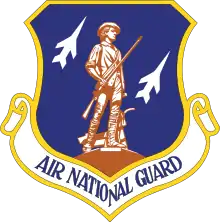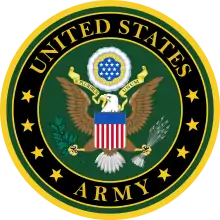Louisiana Army National Guard
The Louisiana Army National Guard is a component of the United States Army and the United States National Guard. The Constitution of the United States specifically charges the National Guard with dual federal and state missions. When not Federalized the National Guard is the only United States military force empowered to function in a state status. Those functions range from limited actions during non-emergency situations to full scale law enforcement of Martial law when local law enforcement officials can no longer maintain civil control. The National Guard may be called into federal service in response to a call by the President or Congress.
| Headquarters, State Area Command Louisiana Army National Guard | |
|---|---|
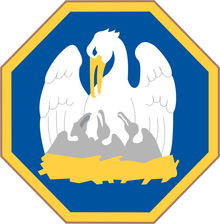 Distinctive unit insignia | |
| Country | United States |
| Allegiance | Louisiana |
| Branch | United States Army |
| Type | ARNG Headquarters Command |
| Part of | Louisiana National Guard |
| Garrison/HQ | Jackson Barracks, New Orleans |
| Commanders | |
| Current commander | Brigadier General D. Keith Waddell |
| Notable commanders | Raymond H. Fleming |
| Insignia | |
| Seal of the Army National Guard | 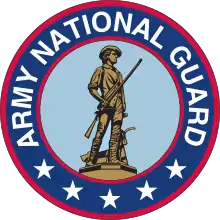 |
Currently, there are approximately 11,500 soldiers serving in the Louisiana Army National Guard. The Louisiana National Guard maintains 74 units in 44 parishes (56 armory locations) across the state.
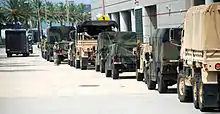
History
The Louisiana Army National Guard was originally formed in the "18th Century when a militia was formed from among the civilian inhabitants of Colonial Louisiana to assist Royal French and Spanish troops in protecting the colony and preserving the peace"[1] The Militia Act of 1903 organized the various state militias into the present National Guard system.
Several units of the Louisiana Army National Guard were activated in support of Operation Desert Shield/Desert Storm in 1990-1991. These included the 159th Mobile Army Surgical Hospital, which operated the only active hospital in southern Iraq in support of the 3d Armor Division during the ground war; the 812th Medical Detachment (Air Ambulance), which flew multiple Medevac missions during the ground war; the 3673rd Maintenance Company, which included members awarded the Bronze Star for their rescue actions during the Scud attacks in Dharan; and the 39th Military Police company, which assisted in managing the large number of POWs captured.
The 2003 invasion of Iraq saw the call up of several units including the 204th ATSG and the 1083rd, 1084th, 1086th, and 1087th transportation companies which upon entering the theater of operation fell under the command of V Corps during 2003-04. During OIF III (Operation Iraqi Freedom 3) the 256th Infantry Brigade served a combat tour during 2004-2005. Units of the 225th Engineer Brigade have been mobilized for duty in both Iraq and Afghanistan. Additionally, aviation components such as the 1/244th Aviation Helicopter Battalion, 204th Theater Air Operations Group and the 812th Med Company have served in an active capacity for OIF multiple times at one year intervals. 165TH CSS BN Mobilized in 2008. 773RD MP BN has mobilized as separate companies. 159TH Air Guard SQDN has been mobilized. 256TH IBCT mobilized for a second tour to Iraq on 5 January 2010. The 415th Military Intelligence Battalion mobilized for a second tour to Afghanistan on 29 Nov 2010.
After Hurricane Katrina the LA ARNG organised Joint Task Force Gator to assist in relief efforts.
Training
Louisiana Army National Guard units are trained and equipped as part of the United States Army. The same ranks and insignia are used and National Guardsmen are eligible to receive all United States military awards. The Louisiana Guard also bestows a number of state awards for local services rendered in or to the state of Louisiana.
Duties
National Guard units can be mobilized (called up) at any time by presidential order to supplement regular armed forces, and upon declaration of a state of emergency by the governor of the state in which they serve. Unlike Army Reserve members, National Guard members cannot be mobilized individually (except through voluntary transfers and Temporary DutY Assignments TDY), but only as part of their respective units. However, there have also been some individual activations to support Federal military operations (2001-?).
Service
For much of the final decades of the twentieth century, National Guard personnel typically served "One weekend a month, two weeks a year", with a small portion of each unit working for the Guard in a full-time capacity. New forces formation plans of the US Army were announced in early 2007 modifying the recent (2001–2006) National Guard active duty callup pace. The new plan will nominally anticipate that each National Guard unit (or National Guardsman) will serve one year of active duty for every five years of service. Secretary of Defense Robert M. Gates imposed "a one-year limit to the length of Federal deployments for National Guard Soldiers." Call ups by Louisiana authorities for state emergencies are not included in this policy.
Units and Formations
- Joint Force Headquarters Louisiana (JFHQ-LA)
- 256th Infantry Brigade Combat Team[2]
- 141st Field Artillery Regiment[2]
- 2nd Battalion, 156th Infantry Regiment[2]
- 3rd Battalion, 156th Infantry Regiment[2]
- 769th Engineer Battalion[2]
- Special Troops Battalion[2]
- 108th Cavalry Regiment[2]
- 199th Brigade Support Battalion[2]
- 225th Engineer Brigade[3]
- 205th Engineer Battalion[3]
- 527th Engineer Battalion[3]
- 528th Engineer Battalion[3]
- 61st Troop Command[4]
- 139th Regional Support Group[5]
- Company B, 136th Expeditionary Signal Company[5]
- 156th Infantry Band[5]
- 415th Military Intelligence Battalion[5]
- 165th Combat Sustainment Support Battalion[5]
- 756th Medical Company[5]
- 773rd Military Police Battalion[5] - Camp Beauregard, Pineville, Louisiana. The 773d gets its numerical designation from the World War Two 773rd Tank Destroyer Battalion of the same name.
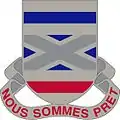 199th Regiment (Regional Training Institute)[6]
199th Regiment (Regional Training Institute)[6]
- State Aviation Command
- 204th Theater Airfield Operations Group
- 1st Battalion (Assault), 244th Aviation Regiment[7]
- 2nd Battalion, 244th Aviation Regiment[7]
- Detachment 38, Operational Support Airlift[7]
- 204th Theater Airfield Operations Group
- 256th Infantry Brigade Combat Team[2]
Facilities
- Camp Beauregard - Pineville
- Army Aviation Support Facility #2 at Esler Airfield - Pineville
- Camp Minden, site of the deactivated Louisiana Army Ammunition Plant; the National Guard headquarters is at Bolin Hall, named for the late Judge James E. Bolin.[8] - Minden
- Camp Cook - Ball
- Camp Villere - Slidell
- Army Aviation Support Facility #1 at Hammond Northshore Regional Airport - Hammond
- Gillis W. Long Center - Carville
- Jackson Barracks - New Orleans
Historic units
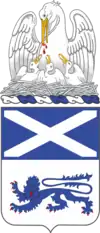 156th Infantry Regiment
156th Infantry Regiment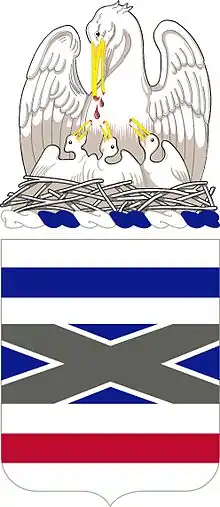 199th Infantry Regiment
199th Infantry Regiment 108th Cavalry Regiment
108th Cavalry Regiment 141st Field Artillery Regiment
141st Field Artillery Regiment- 159th Mobile Army Surgical Hospital (deactivated)
- Troop E, 256th Cavalry
State Partnership Program
Louisiana has two countries in the SPP (State Partnership Program). Belize joined the SPP with Louisiana National Guard in 1996 and Haiti in 2011. Both of these nations fall under the area of operations of SOUTHCOM.
See also
Notes
- "Louisiana Army National Guard". GlobalSecurity.org. Retrieved 14 April 2007.
- "256th Infantry Brigade Combat Team". Louisiana National Guard. 30 October 2019.
- "225th Engineer Brigade". Louisiana National Guard. 30 October 2019.
- "61st Troop Command". Louisiana National Guard. 30 October 2019.
- "139th Regional Support Group". Louisiana National Guard. 30 October 2019.
- "199th Regiment (RTI)". Louisiana National Guard. 30 October 2019.
- "State Aviation Command". Louisiana Army National Guard. 18 December 2016.
- "Louisiana Guard honors memory of leader, WWII veteran". dvidshub.net. Retrieved 29 May 2013.
References
- Louisiana National Guard, accessed 2004-04-14
- GlobalSecurity.org Louisiana Army National Guard, accessed 2007-04-14
- Unit Designations in the Army Modular Force, accessed 2006-11-26
External links
| Wikimedia Commons has media related to Louisiana Army National Guard. |
